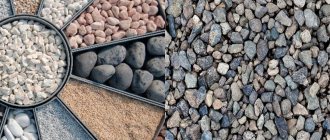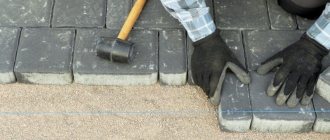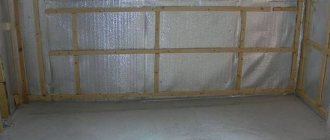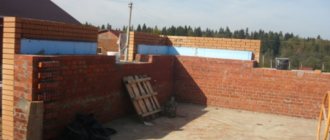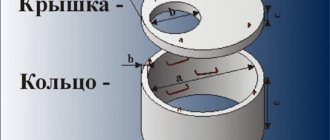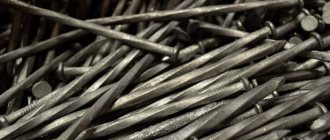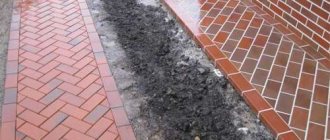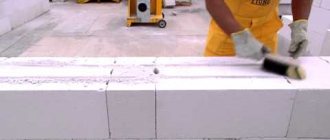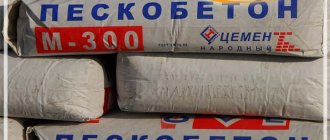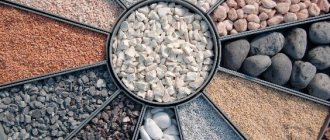Application of a concrete hardening and setting accelerator
Normal concrete hardening is a long and responsible operation. The final characteristics of the product, such as strength and durability, will depend on its flow. But in some cases it is not possible to wait the required 28 days or it is simply impractical. Then accelerators come into play, “accelerating” chemical processes, but not worsening the quality of the fill.
Table of contents:
Features of concrete setting
The hardening process of the solution occurs with the participation of water. Optimal hydration conditions are considered to be an air temperature of about +20°C and a relative humidity of at least 90%. Moreover, the humidity regime must be constantly maintained, otherwise the hardening of concrete will stop. If there is a lack of water during the hardening period, the structure will lose its solidity and become fragile.
When you need to speed up this process:
1. When performing work in winter, reducing the air temperature to 0°C stops the hardening of the solution. In cold weather, moisture completely turns into ice. To ensure normal hardening of concrete, it has to be heated, and setting and hardening accelerators reduce the heating time, reducing energy costs.
2. If early stripping is necessary (when the turnaround time of the equipment is important).
3. To resume construction work before the 4-week hardening period for the mortar has expired.
4. When producing large volumes of piece reinforced concrete products. The use of accelerators in these cases allows you to make do with a smaller set of molds and produce batches of high-quality goods faster.
5. To optimize the plastic properties of the solution and the strength characteristics of concrete that has undergone hardening (by revising the water-cement ratio).
Varieties
| Chemical affiliation | Guest accelerators | |
| Name | Formula | |
| Carbon dioxide salts | Potash | K2CO3 |
| Sulfate salts | Sodium sulfate | Na2SO4 |
| Nitrates | Calcium and sodium nitrate | Ca(NO3)2, NaNO3 |
| Ammonium salts | Urea | CO(Nh3)2 |
| Chlorides | Calcium | CaCl2 |
| Sodium | NaCl |
Of the set accelerators listed, the most widely used are chloride-based mixtures. They are highly effective and inexpensive. The only limitation is that subsequent autoclave processing of products is no longer possible.
Concrete hardening accelerators are plasticizing additives and are added at the stage of preparing the solution, mixing evenly with the other components. Moreover, their quantity in concrete should not exceed certain values - each accelerator has its own limitations.
Most plasticizer-accelerators cannot be used for mortars based on alumina cement, as well as in the presence of reinforcement made of thermally hardened steel. These restrictions do not apply only to sodium sulfate.
Popular Supplements
1. Station wagon P-2. Allows you to avoid steaming concrete products, and concrete already at the age of 30 hours gains from 50 to 85% of the declared strength. The hardening accelerator contains anti-corrosion additives that protect metal reinforcement.
2. Fort UP-2 - a complex composition based on sodium salts, which increases the rate of concrete hardening by approximately 30%. The modifier increases the mobility of the mixture to class P5, regardless of the water-cement ratio. This property of the Fort UP-2 accelerator allows you to increase the final strength of the structure up to 150% at the end of hardening by reducing the volume of water. Or obtain the required grade of concrete with less cement consumption. Used for the manufacture of high-density products with improved surface quality. Dosage – 0.5-0.7% dry accelerator in relation to the mass of cement.
3. Asilin-12 is a liquid hardening accelerator used for the production of foam concrete blocks. The use of Asilin is advisable when it is impossible to maintain a stable pouring temperature. It is recommended to add it to the solution to accelerate hardening if the air temperature exceeds +25°C or does not reach +10°C. The content of Asilin-12 in relation to the mass of cement ranges from 0.4-1% for lightweight concrete and 0.5-2% for heavy concrete.
4. Calcium chloride. It not only accelerates the hardening of concrete, but also improves its wear resistance and resistance to atmospheric influences. As a result, the products mature 2.5-3 times faster, and their quality increases. Calcium chloride draws moisture necessary for hydration processes directly from the air and retains it in the thickness of concrete, ensuring normal humidity conditions. Dosage is 0.5-2% of the cement mass in reinforced concrete structures and up to 3% in unreinforced monoliths.
5. Relaxol. Used as a setting accelerator and anti-frost plasticizer. Allowed for use at temperatures not lower than -15 °C. Thanks to Relaxol, the hardening rate increases by 30-40% in the first 3 days, the dosage is 0.5-2.5%.
6. Relamix accelerator is a whole line of plasticizing additives that reduce the setting time of cement mortars:
- Relamix-M and Relamix-M2 - to increase the hardening speed of concrete that will work in an aggressive environment.
- Relamix-Guncrete is intended for the production of alkali-free solutions for machine application.
- Relamix-PK - does not contain chlorides, therefore it is freely used to accelerate the hardening of reinforced concrete products.
- Relamix-SL – on potassium and sodium salts. It has the widest scope of application - from cellular concrete to the manufacture of high-strength prefabricated structures.
The accelerating additive Relamix reduces the cost of concrete steaming by 1.5-2 times or allows you to eliminate it altogether. In this case, the structure of the monolith is more dense, resistant to water and negative temperatures. Dosage – 0.6-1%.
7. Concrete-F. In the first day, the accelerator provides twice as much strength, but in general, hardening occurs 2-3 times faster. At the same time, the surface is particularly resistant to wear and has a good presentation. Concrete-F is recommended as a plasticizing additive in concrete for paving slabs, fence sections and other molding products with high requirements for strength and decorativeness.
8. Foreign products on our market:
- Cementol Omega P (Slovenia) – along with a reduction in setting time, provides concrete with increased water resistance. Dosage – 1-2.5%.
- Addiment BE2 (Germany) – accelerator for machine applied solutions. Dosage – 2-4.5%.
- BE5 is an anti-frost additive to improve the hardening of concrete. Dosage – 1-2.1%.
- BE6 – is supplied already in the form of a ready-made composition and is intended for the preparation of repair mixtures with particularly fast setting.
Price
Many universal compositions have appeared on the market, allowing not only to speed up the hardening process, but also to improve some of the characteristics of concrete. But compared to less “functional” additives, such modifiers are not much more expensive, since the most expensive component in them is the accelerator itself.
| Accelerator | Packaging, kg | Price, rubles |
| Concrete-f | 15 | 2 700 |
| Calcium nitrate | 25 | 1 375 |
| Relaxol S-3 | 25 | 900 |
| Sodium formate | 25 | 900 |
| Calcium chloride granules | 25 | 750 |
| Fort Up-2 | 20 | 600 |
| Asilin-12 | 65 | 2 390 |
| Relamix | 25 | 2 000 |
stroitel-list.ru
Concrete hardening and setting accelerator
Natural hardening of concrete is a rather long and responsible process.
The quality of the product depends on how it proceeds. But if, for some reason, it is not possible to wait several days, in this case builders use accelerators.
Accelerators speed up chemical processes without compromising the quality of the pour. The solution cannot harden without water.
In this article we will talk about concrete hardening accelerators.
Conditions for the use of concrete hardening accelerators
The favorable temperature for hydration is plus twenty degrees and humidity ninety percent. Humidity must be constantly maintained to ensure that the hardening process does not stop.
If there is not enough water during the hardening process, the structure will be fragile and lose its solidity.
At zero temperature, concrete does not harden.
At very low temperatures, water becomes ice. To ensure concrete hardening, it is heated and, thanks to hardening accelerators, the heating time is significantly reduced.
In what cases are concrete hardening accelerators used?
- When construction work is carried out during the cold season, that is, in winter.
- If there is a need to remove the formwork earlier.
- So that construction work can resume before the concrete has cured.
- When producing large volumes of piece reinforced concrete products.
If you use concrete hardening accelerators, you can use fewer forms in the manufacture of reinforced concrete products, while the quality of the products will remain unchanged.
To optimize the strength properties of concrete and the plastic properties of mortar that has undergone hardening, chloride-based mixtures are used in construction.
Such mixtures are highly effective and low in price. But there is only one drawback - the finished product cannot be processed in an autoclave.
Additives that accelerate concrete hardening are plasticizers and are added when mixing concrete along with all the ingredients. The additive for rapid hardening of concrete must be added in doses.
Many additives cannot be used for mortars made of aluminous cement, and the use of reinforcement made of thermally strengthened steel in concrete products is also unacceptable. These restrictions do not apply to sodium sulfate.
Supplement Review
Additives that are popular, as well as their brief descriptions, are listed below.
Station wagon P-2
This additive allows you to avoid steaming reinforced concrete products, and the concrete also gains its strength faster. This hardening accelerator contains anti-corrosion additives that contribute to the safety of the reinforcement.
Fort UP-2
This supplement is complex. It is prepared on the basis of sodium salts, which increase hardening by about thirty percent.
This additive increases the mobility of the concrete mixture to class P5 and this does not depend on the ratio of water and cement. This quality of Fort UP-2 allows you to increase the strength of the structure up to one hundred and fifty percent by reducing the amount of water.
This additive is used to produce high-density products with improved surfaces.
Asilin-12
Produced in liquid form, used in the production of foam blocks.
Asilin -12 is added to the concrete mixture when the air temperature is plus twenty-five degrees or does not reach plus ten degrees.
Calcium chloride
Accelerates hardening and improves wear resistance of concrete. Calcium chloride draws water directly from the environment and holds it in the concrete.
The product turns out to be of high quality and matures 2.5-3 times faster!
Relaxol
Antifreeze plasticizer and hardening accelerator. Used at temperatures of minus fifteen degrees.
When this plasticizer is added, concrete hardens within three days.
Accelerator Relamix
These are several types of plasticizing additives that reduce the rapid hardening of concrete.
Relamix-M and Relamix-M2. These additives are needed to increase the hardening speed of concrete in order to work with it in an aggressive environment.
Relamix-Guncrete, this plasticizer is necessary for the production of non-alkaline solutions that are applied by machine.
Relamix-PC, it does not contain chlorides in its composition, for this reason it is used as an additive for the rapid hardening of reinforced concrete products.
Relamix-SL, it is based on potassium and sodium salts. It is most often used for cellular concrete and for high-strength structures.
Concrete-F
The accelerator provides strength gain in the first day, and hardening occurs 2-3 times faster.
The surface of a product or structure with the addition of this plasticizer is particularly resistant to wear.
Concrete-F is added to concrete in the manufacture of paving slabs, fences and other molding products.
Cementol Omega P
This plasticizer is produced in Slovenia, ensures rapid hardening and high water resistance.
Addition BE
BE2 - made in Germany. This type of plasticizer is produced for solutions that must be applied by machine.
BE5 is an antifreeze additive.
BE6 - this additive is delivered ready-made and is added to prepare repair mortars for quick setting.
There are many universal additives for accelerating the hardening of concrete, and they can also improve the quality of concrete. But if you compare less functional supplements with these ones, they will cost more and the most expensive component is the accelerator. We hope you found this article informative.
domsdelat.ru
Types of hardening agents
Two methods of strengthening concrete pavement are used in construction:
- Topping.
- Impregnations.
It is worth considering each of these methods in more detail, noting their features and the types of means used.
Topping for concrete
We strengthen the concrete surface with topping using a special trowel.
This method can be compared with ironing, when fresh concrete is strengthened by grouting dry mixtures. However, the ironing method, despite the “iron” name, does not provide a very durable surface. For this reason, Portland cement with special chemical additives is used.
Based on their chemical composition, there are several types of topping:
The quartz filler is white and can be painted over with special coloring mixtures
- Quartz. Affordable and most common. The filler in them is purified fine fractions of quartz sand. Due to this, the surface also becomes decorative, especially if coloring pigments are used. This type of topping is used for floor coverings that are subject to medium loads. These include warehouses, shopping centers, medical or educational institutions. Quartz concrete hardener improves resistance to mechanical loads up to 1.5 times.
Attention! Quartz topping is also used in residential areas. In addition, it allows concrete to withstand exposure to large amounts of moisture in swimming pools, bathhouses, etc.
- Corundum. Corundum fillers are distinguished by their high resistance to abrasive influences. The use of this mineral strengthens the floor surface up to 1.6-1.8 times to mechanical loads, and increases abrasion resistance by 2 times. In terms of scope of application, corundum additives are intended for industrial premises with heavy equipment and high traffic. One can also note their decorative effect, which is accompanied by the appearance of a characteristic matte shine.
Reinforcement with metal shavings is not suitable for residential premises
- Metal. The most durable of all topping fillers. The mixture contains small metal shavings, which make the floor up to 2 times more resistant to mechanical stress. They are used exclusively for industrial premises with massive equipment and high intensity of movement of heavy equipment, as well as under other possible vibration impacts.
As you can see, the topping method is very effective. At the same time, there are funds for both residential and industrial premises. Metal topping is not used in residential construction because it unnecessarily strengthens the concrete. This increases the cost of work. In addition, hygiene and aesthetic requirements are taken into account.
Impregnations for concrete
Liquid composition for hardening
In this technology, the principle of creating a coating with a hardened top layer is completely different. In the crystal lattice of concrete there are cavities containing unbound substances or with partial connection.
Attention! If these substances in the structure of concrete are exposed to certain chemical reagents, they will acquire a connection with the crystal lattice, thereby clogging the pores and strengthening the surface.
These liquid chemicals that penetrate concrete and strengthen its structure have a special name - sealers. The concrete surface hardener in the liquid state can have a wide variety of compositions: containing mineral or organic substances.
The action occurs at the molecular level
They all act the same way: they penetrate the porous structure, fill capillaries and cracks in the concrete surface, in which all chemical fillers are neutralized. In this case, after a chemical reaction, a kind of gel is formed, which expands and fills the structure, creating a monolithic surface. This prevents the penetration of moisture into the concrete, which can lead to deterioration of strength, corrosion of the reinforcing layer, and the generation of dust due to abrasive abrasion of the surface.
As you can see, a chemical liquid concrete hardener has many advantages. They are also easy to use. For topping it is necessary to use special trowelling machines, and liquid products can be applied with a roller. In the first case, hardening is carried out on fresh concrete, and even the old layer can be restored with impregnations.
Features of using a composition containing litum in a liquid state for strengthening concrete.
Accelerators for setting and hardening of concrete mixtures
According to building codes, the standard hardening period for concrete mixtures and mortars with cement is 28 days, while their quality and performance characteristics largely depend on setting conditions and strength development. In order to speed up these processes, special additives are introduced at the preparation stage. Their presence significantly reduces the initial setting stage and allows for improved mobility without disturbing the water-cement ratio. Products are presented by domestic and foreign manufacturers, prices are influenced by functionality and efficiency.
Table of contents:
Features of concrete hardening, feasibility of using accelerators
The main condition for the preparation of cement mortars is mixing with water; strength gains are carried out gradually. At the initial stage of hydration (setting), it is important to maintain a high level of humidity and positive ambient temperature (not lower than +5 °C, ideally about +20). Violation of these conditions negatively affects the hardening process: moisture remains inside the concrete or is removed too quickly, the artificial stone loses its strength and begins to color. If it is necessary to eliminate dependence on weather or time, additional measures are required: heating or introducing chemical impurities. But any of these methods increases the cost estimate; their use must be economically justified.
Adding concrete hardening accelerators is advisable when:
- Concreting structures in the cold season, including when combined with electric heating.
- Production of reinforced concrete products and piece shaped products: tiles, border elements. Reducing the hardening time in this case makes it possible to use fewer forms, and improving the mobility of the solution has a positive effect on the appearance, strength and wear resistance.
- Pouring monolithic structures, in particular, with limited formwork turnover time. The maximum effect of reducing hardening time is observed when using a sliding variety.
- Restrictions on the timing of work (accelerators can reduce them by 2-3 times).
- The need to increase the mobility of the solution without changing the water-cement ratio and reducing strength, for example, when mixing lightweight concrete.
Compositions based on sulfate, carbon dioxide and ammonium salts, nitrates and chlorides of calcium and sodium help to speed up the hardening process. The choice of a specific type depends on the type of structure being poured, in particular, the presence of reinforcement. Nitrates and potash do not cause corrosion and are suitable for pouring prefabricated monolithic reinforced concrete elements at sub-zero temperatures (down to -25 °C). Aqueous solutions of salts significantly reduce the setting time of concrete and require immediate consumption of the prepared mixture due to the rapid loss of plasticity.
Calcium chloride, for all its prevalence and effectiveness (increasing strength by 1.7 times on the third day of hardening with the introduction of only 2% and improving mobility) is not used when pouring pre-stressed structures or products with thin reinforcement.
Review of domestic and foreign compositions
Among the popular Russian brands are the Relamix and Fort lines, complex and multifunctional additives Universal P-2, Asilin-12, Bitron, Lignopan, Concrete-F. Pure substances are also used: calcium chloride, potash, potassium nitrate, sodium sulfates and aluminates. Most foreign accelerators belong to superplasticizing complex additives for concrete. Among them are Coral MasterFix, Cementol Omega P and the Addiment line.
A complex hardening accelerator that provides an increase in strength from 30 to 70% of the norm in the first day in mortars based on Portland cement with varying degrees of mobility (increasing them to P5). It is a dry brown powder based on sodium salts, introduced after preliminary mixing with water. Adding Fort UP-2 allows you to reduce binder consumption by 8-12% and increase the final strength of products by 10%. In addition to standard building mixtures, the scope of application includes ready-mixed, lightweight and cellular concrete; the maximum effect is achieved when hardening monolithic structures and producing reinforced concrete products without steaming.
A composition based on calcium chloride, which significantly reduces the hardening time. The advantages of its use include increased resistance to surface wear (strength increases by 1.5 times or more), sub-zero temperatures and accelerated release of poured elements from molds and formwork. Completely dissolves in water and is added when mixing dry ingredients. The characteristics of Concrete-F are well suited for preparing concrete for paving slabs; in addition to speeding up the production process by 2-3 times, such products have virtually no chips or voids.
Superplasticizer produced in the form of powder, paste or aqueous solution. It has combined properties and is used both to accelerate the setting process and gain strength, and as an antifreeze additive. It is recommended when pouring concrete into monolithic structures (due to rapid hardening, the formwork can be removed within 24 hours), combined with electric heating (the duration is reduced by 3-6 hours) and mixing with non-standard fillers. The introduction of this additive allows you to reduce cement consumption by up to 30%.
Products of the German manufacturer Sika, a generally recognized leader in the production of construction chemicals. It is presented as accelerators in the form of powders and ready-made mixtures used for various purposes: for machine application, for work in winter, for reducing setting time. The advantages include improving the structure of concrete and increasing its water resistance; the disadvantages are high cost. The dosage depends on the variety and varies from 1 to 5%.
The Poliplast company's product line includes 8 brands with different compositions and intended purposes. All types are complex and, in addition to providing high strength indicators in the early stages of hardening, they improve such characteristics of concrete as water resistance, resistance to aggressive environments and mobility. The maximum effect of the input is observed when preparing high-class solutions (from B40 and above). The advantage is that it is economical, the standard dosage does not exceed 1%.
Cost of accelerators for concrete
| Name, country of origin | Additive type | Recommended dosage, % by weight of cement | Packaging, kg | Price, rubles |
| Fort UP-2, Russia | Complex, to accelerate hardening | 0,5-0,7 | 20 | 1000 |
| Concrete-F, Russia | Plasticizing agent, recommended for the manufacture of molding products | 0.5-2 – under normal hardening conditions, up to 3 – when pouring unreinforced structures | 15 | 2700 |
| Relaxor S-3R, Russia | Superplasticizer with antifreeze properties | 0,5-2,5 | 25 | 850 |
| Cementol Omega P, Slovenia | Improves water resistance | 1-2,5 | 50 | 5350 |
| Addiment BE2, Germany | Composition for shotcrete application of mixtures | 2-4 | 5 | 3150 |
| Addiment BE5, concentrate 1:4 Germany | Anti-frost additive, provides rapid hardening and good water resistance | Up to 5 | 5 | 3360 |
| Relamix M2, Russia | Strengthening accelerator for all types of concrete, suitable for densely reinforced structures | 0,6-1 | 50 | 4200 |
stroitel-lab.ru
Interhard-Li
| Concrete surface hardener. The inorganic concrete hardener "Interhard" is a lithium-based liquid compound modified with highly effective surfactants. The presence of lithium makes it possible to reduce the viscosity of Interhard, ensuring its penetration into concrete to a depth of ~30 mm, with the formation of insoluble compounds in the pores and capillaries, compacting and strengthening the structure. Retail price 455 rub./l Packaging 10 l |
Purpose: The Interhard composition is intended to increase the strength and wear resistance of the concrete surface, prevent the formation of dust during the operation of floors, compact the surface layer with a corresponding increase in water resistance, frost resistance and a decrease in water absorption.
Penetrates deeply:
| The smallest radius of lithium atoms ensures deep penetration (~ 30mm) of Interhard into the concrete structure | Other hardeners penetrate no deeper than 2-10 mm |
Description: Interhard is a modified silicate solution containing lithium. The solution saturates the surface of the concrete, penetrates into the capillaries and pores. It enters into a chemical interaction with the hydration products of cement clinker, primarily with calcium hydroxide Ca(OH)2 and calcium carbonate CaCO3. As a result, poorly soluble new formations are formed that compact the microstructure of concrete. The presence of the lithium component ensures deep penetration of the solution (up to 20-30 mm) due to its particularly low viscosity, determined by the smallest of all elements of the periodic table sizes of lithium atoms.
Scope of application: Interhard is used to improve performance properties:
- floors of garages, open parking lots, industrial premises, premises with heavy pedestrian traffic - floors of shopping centers, warehouses, hospitals;
- top coverings of cargo berths, cargo areas of river and sea ports;
- facade surfaces of reinforced concrete structures exposed to atmospheric influences.
Advantages of Interhard:
- Possibility of compacting the concrete structure of new and old floor surfaces, preventing dust formation, increasing wear resistance.
- Seals cracks with an opening of up to 0.1 mm.
- Increases the durability of concrete by preventing carbonation and the penetration of chloride ions.
- Allows (if necessary) the application of finishing materials containing cement, increasing their adhesion to the substrate.
- Simple technology for performing work.
Increases the strength of the concrete surface:
Method of application: The concrete surface must be dry, clean, without traces of laitance and foreign coatings. Cleaning by mechanical and chemical methods is allowed. When cleaning with a weak (5%) solution of hydrochloric acid (HCl), the latter should be thoroughly rinsed with water under pressure. Uneven surfaces can be removed using mosaic sanding machines. Before applying Interhard, the surface should be free of dust. "Interhard" is applied at temperatures of the concrete structure and outside air in the range of +5 °C +40°C. Stir before applying Interhard. Application to the surface is carried out on concrete aged more than 14 days by uniform spraying or pouring with distribution over the surface with a brush. The surface must be completely moistened with Interhard, avoiding the formation of puddles. Consumption – 1 liter per 4-6 m2. 4-6 hours after applying Interhard, the surface of the treated concrete should be moistened by spraying water at a flow rate of 0.1-0.15 l/m2. For concrete with increased absorbency, it is advisable to apply Interhard twice. Secondary application is carried out after the surface has dried. Interhard is repeatedly applied to the surface at a consumption of 1 l/10 m2. 4-6 hours after re-application of Interhard, the surface should be moistened again by spraying water. It is advisable to repeat moisturizing 2-3 times with an interval of 20-24 hours.
| Abrasion tests | |
| Control sample | Sample treated with Interhard |
Specifications:
| The name of indicators | Characteristics or norms |
| Chemical base | Modified silicate solution containing lithium |
| Appearance | The solution is light beige, transparent or translucent, a whitish precipitate is acceptable. |
| Density at 25°C | 1.22 g/cm3 |
| Mass fraction of non-volatile substances, %. | 48,0-52,0 |
| Viscosity at 25°C | 0.1 Stokes |
| pH no less | 12 |
| Dry matter content | 40 |
Consumption: Consumption depends on the absorbency of the concrete.
Packaging: Interhard is supplied in 10 and 20 liter canisters.
Storage: Canisters should be stored in a sealed state - with a tightly closed lid without access to oxygen at an air temperature not lower than +5°C and not higher than +50°C. Canisters containing Interhard should not be exposed to direct sunlight for long periods of time. Thorough mixing is required before use. Shelf life: no more than 6 months.
Precautionary measures: When working with Interhard, precautions must be taken (use of safety glasses or a mask, gloves). If Interhard gets on your skin, you should immediately douse it with water. In case of contact with eyes, rinse them immediately with plenty of water.
Concrete hardening process
When constructing any objects, the most important thing is a high-quality foundation on which the building or house stands. Concrete mixtures are often used to fill the foundation or slab. In order for buildings to withstand any loads on the foundation in the future, you need to use mixtures of excellent quality for it. The poured foundation itself must be ready for the construction of walls and subsequent floors above it, that is, it is necessary to wait a certain period in order for the concrete to harden. How does this process happen, how long does it take and is it possible to speed up hardening?
The mixtures are used to fill the bases of structures and floor slabs.
Hardening process
After cement and water are mixed to produce a solution, a complex interaction begins between them, as a result of which a completely new compound is formed with its own characteristics. Water gradually penetrates into the cement grains, the minerals of which enter into a chemical reaction with it. During this reaction, minerals are converted into potassium hydrosilicates. This process is called concrete hardening.
The degree of concrete hardening can be checked using specialized diagnostic tools.
Hardening is not completed in one day. In order for concrete to gain the strength it needs and cease to be plastic, a certain period of time is required. This is called the hardening time. Hardening can last for years, which can significantly extend the construction process for a very long time. Builders cannot wait that long, and they have calculated a target setting period after which the foundation can withstand the design load.
Control period of setting
In order for concrete to reach its original compressive strength, favorable conditions are needed. These include ambient temperature and air humidity.
At high temperatures and air humidity, hardening proceeds faster, and at low temperatures it slows down. Exposure to zero and negative air temperatures can stop the setting process. The optimal temperature for hardening is 20-30 degrees above zero, air humidity should not be below 90%. In laboratory conditions, it was found that the most active hardening under the described conditions occurs in the first week after it is poured. During this period, concrete can gain up to 70% of its strength. Reaches 100 percent brand strength 28 days after pouring.
Curing schedule as a function of temperature.
In real conditions, the air temperature cannot be constant: it is higher during the day and lower at night, and humidity also changes at different times of the day. Therefore, experts recommend waiting a few more days to erect the building on its foundation. Thus, construction work can be continued no earlier than a month after pouring.
Although 28 days is considered optimal for construction work, in some cases it needs to be increased. We are talking about structures that will constantly come into contact with moisture during operation. These are piers, dams, dams. The hardening of such structures with their strengthening takes 3 months. As mentioned above, hardening continues after 28 days and after six months. However, this process is much slower than the initial stages of setting and guarantees the reliability of structures that become even harder and stronger over time.
